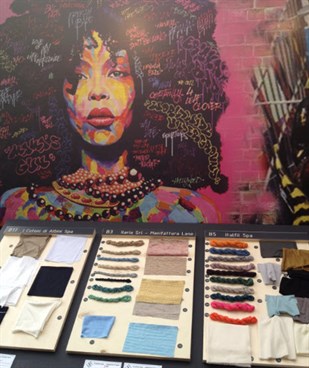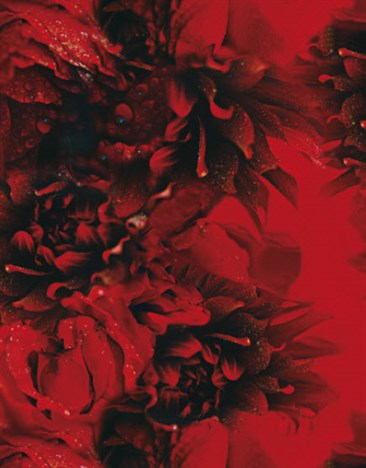 |
| Directional yarns for 2015 shown at Filo, Milan with creative graphics |
Prints are driving the fashion engine for Autumn/Winter 14/15, and rapid advances in digital printing are the reason why. Designers can specify large numbers of different designs in a short lead time.
This flexibility is leading to the emergence of a more creative set of variations on a theme, each season, in the fashion fabrics on show at Milano Unica and Première Vision, and in prototypes at yarn shows like Filo, where novelty yarns are demonstrated by images and samples.
At the latest editions of these shows, bright and unusual colour creativity chimed well with a more positive economic outlook, especially in projected trade with the developing markets in China. Complexity and colour were major themes, perhaps influenced by a more vibrant colour palette.
Complexity came in the blends of fibres, and in the way fabrics are knitted or woven, using jacquards, slubbed yarns and creating three dimensional images. Overprints produced trompe l’oeil techniques to make intriguing planes and perspectives.
Embellishment is the word used at retail for adding to fabrics by embroidery, the addition of ribbons and jewels, stitching and printing. Print techniques are key to the complex looks popular for 2015, uniting various textures and colour tones. A handmade look is achieved by the use of appliqués stitching, brushing and teasing fabrics, further enhanced by printing on classic fabrics like colour-woven shirtings with small paisley motifs or surprising images superimposed on the traditional stripe or check.
Classic designs are rejuvenated by the addition of extra motifs such as paisley shapes in pinks, oranges and reds, mixed with multicoloured dots of different sizes. Very small wallpaper prints had splashes, graffiti or smudged effects. At Première Vision a grouping of Japanese artists – Mika Inagawa, Fantasista Utamaro and weaver Komatsu Seiren – showed their take on florals, photographic plants and sea creatures.
Flowers bloomed in both Milan and Paris, brightly coloured, often in patchwork effects, using bright yellows, reds, oranges and greens, very much Chinese-influenced. Techniques gave them a textured look with layers of printed design superimposed. They were not confined to dress weights, but were quilted for outerwear, including performance-enhanced jackets, used for trainers and suggested for accessories from hats to bags.
Printed wool gave a young, vibrant look to warm, fuzzy fabrics for winter, highlighting the move to emphasise the fashion appeal of wool to a younger audience. Printed linens were also on show at PV on the CELC/Masters of Linen stand, emphasising versatility and making the fabrics a canvas for an ultra-modern look.
One of these new looks was named Chaos – regular patterns interrupted with unexpected images, different dimensions and colours, sometimes with Jackson Pollock inspired brushstrokes, seemingly random marks and blurred, spilled colour taking over the space. For dresses, T-shirts and coats, repeats were interrupted by random images.
There has been an explosion of fabric design as art, with the freedom to experiment provided by digital techniques, so that large expanses of fabric can display large areas of colours like blue, black and white in broad brushstrokes for dress fabrics.
 |
| Japanese artist Mika Ninagawa designs for fabric at Premiere Vision |
Colours were bright and deep, often verging on the neon, with themes as diverse as goldfish, tropical fish, fruits, strawberries, raspberries, and the contrasting brightness of tropical flowers and petals. Darker themes mixed black with these neon shades. Yellow, from mustard to buttercup, was an accent colour, together with red, pink and shades of green and blue, put together with white for a fresh look at winter. More-sophisticated colours, like grey, black and white, and pale powder-based pastels were used for more abstract designs like geometrics, dots and graphics.
In contrast to these themes were highly coloured ethnic patterns, South American or African, using black as well as brights to present a more disciplined series of repeating themes.
Pop designs such as hearts, flowers and stars were jumbled together in bright neon greens, pinks and blacks for shirt weights. Russian influences included black grounds with bright pinks, yellows and greens, recalling the designs and colours used for traditional Russian dolls
Photographic super-realist designs took an eclectic mix of urban themes like buildings or wet streets, urban night skies or fireworks, scattered across cotton mixes in dark blues or blacks, enlivened with silver or white. Computer influences include pixillated images and hard-edged designs exploiting the power of black-and-white.
Typography yields many opportunities to play with numbers and forms using a geometric theme or assembling letters and numbers to make up another shape. Overlapping images taken from typefaces give a new, unusual way of playing about with patterns and line, with tonal contrast and individual colours in organised or totally chaotic ways.
Camouflage has been important for the summer and continues into the winter of 14/15, interpreted in heavier weight woven cottons as well as lightweight breathable shirtings and jacketings. Released from its usual green, sand or black combinations, the new camouflage uses pink and green, blue and black or red tones to surprise.
The fact that economies of scale and improved techniques are making complicated digital designs and colours more accessible is evidently spurring on experiment and creativity for next year.